
Overview
Enhancing Google Ads performance is crucial for any business aiming to thrive in the digital landscape. This article delves into effective bid strategies that integrate Conversion Rate Optimization (CRO) techniques, showcasing how these methods can elevate your advertising efforts.
By employing strategies such as:
- automated bidding
- competitor analysis
- A/B testing
- user feedback
businesses can significantly improve key performance metrics. For instance, case studies reveal substantial increases in conversion rates and average order values across various companies that have successfully implemented these tactics. These results underscore the importance of a strategic approach to bidding in Google Ads.
To achieve these outcomes, it’s essential to understand the mechanics behind each strategy. Automated bidding allows for real-time adjustments based on performance data, ensuring that your ads are always competitive. Competitor analysis provides insights into market positioning, while A/B testing enables you to refine your messaging and targeting. User feedback is invaluable, offering direct insights into customer preferences and behaviors.
In conclusion, integrating these strategies not only enhances your Google Ads performance but also drives meaningful results for your business. By taking action and implementing these techniques, you position yourself for success in a competitive marketplace.
Introduction
In the competitive landscape of digital advertising, optimizing Google Ads performance is not just important—it's essential. Companies are on a relentless quest for innovative strategies that maximize their return on investment. Understanding the intricacies of bidding can truly make all the difference. This article explores ten powerful bid strategies designed to enhance ad visibility while driving meaningful engagement and conversions. Yet, as businesses implement these tactics, a critical question arises: how can they ensure their efforts translate into real-world success amidst the ever-changing dynamics of the market?
Parah Group: Optimize Your Google Ads with Expert CRO Strategies
Parah Group stands out as a leader in integrating Conversion Rate Optimization (CRO) techniques within Google Ads campaigns, ensuring that every dollar spent yields maximum returns. By leveraging data-informed insights and understanding consumer psychology, Parah Group empowers DTC labels to refine their advertising strategies, resulting in significantly improved success metrics and higher average order values.
For example, a $30M apparel company experienced a remarkable 35% increase in conversion rates after revamping its homepage to emphasize social proof, optimize product pricing, and introduce gamified progress bars for free shipping thresholds. In another instance, a $15M cleaning product company boosted its average order value by 80% through strategic bundling, implementing free shipping thresholds, and utilizing post-purchase upsells. This comprehensive approach not only enhances ad performance but also aligns seamlessly with the brand's overall marketing strategy and bid strategy, fostering sustainable growth and increased profitability.
With proven methodologies like A/B testing—where one variable is tested at a time for accurate results—and personalized landing pages, Parah Group illustrates how effective CRO can convert ad spend into tangible outcomes. Notably, implementing a bid strategy through CRO can reduce cost per acquisition (CPA) from $500 to $200, underscoring the financial benefits of these strategies.
As Pathmonk aptly states, "Without a robust approach to improving performance, ad expenditures are squandered on visitors who are unlikely to engage." This highlights the critical need to address issues such as slow loading times and irrelevant messaging, which can severely hinder success rates.
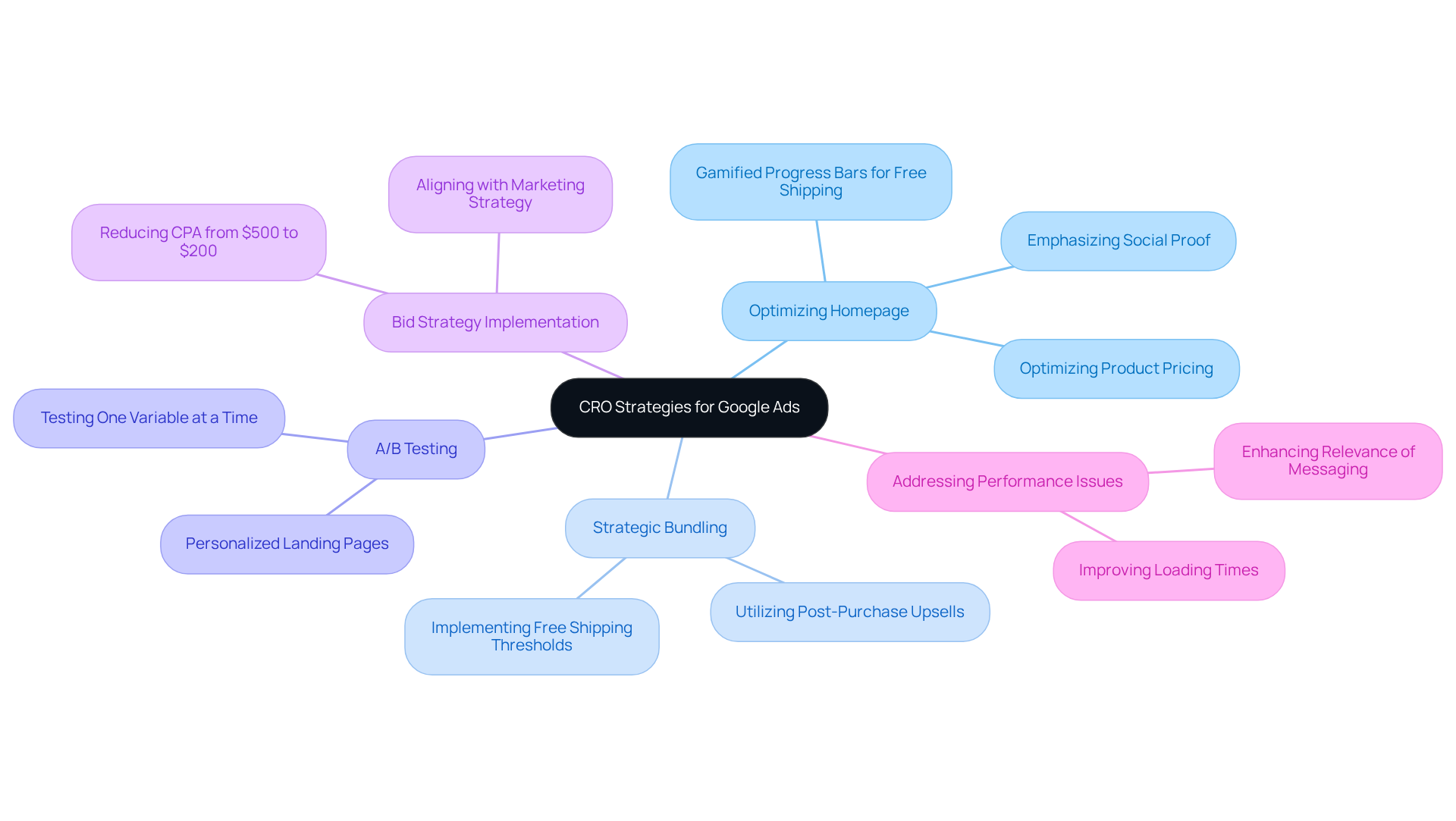
Utilize Automated Bidding for Enhanced Efficiency
Automated bidding methods, such as Target CPA and Target ROAS, are part of a bid strategy that empowers advertisers to set bids automatically based on specific objectives. This strategy not only saves time but also optimizes bids in real-time, ensuring that ads stay competitive without the need for constant manual adjustments. For direct-to-consumer (DTC) companies, leveraging automated bidding allows them to concentrate on strategic planning while the system fine-tunes bids to enhance results, drawing on historical data and performance trends.
Significantly, advertisers employing Target CPA can achieve higher conversions by setting a target cost per action. In contrast, Target ROAS focuses on maximizing conversion value, enabling companies to align their bid strategy with revenue goals. Industry experts emphasize that these automated bid strategies can greatly enhance campaign efficiency, enabling companies to swiftly adapt to market fluctuations and consumer behavior.
As a result, DTC companies can elevate their overall advertising performance and foster sustainable growth. By embracing these automated bidding techniques, businesses not only streamline their operations but also position themselves for long-term success in a competitive landscape.
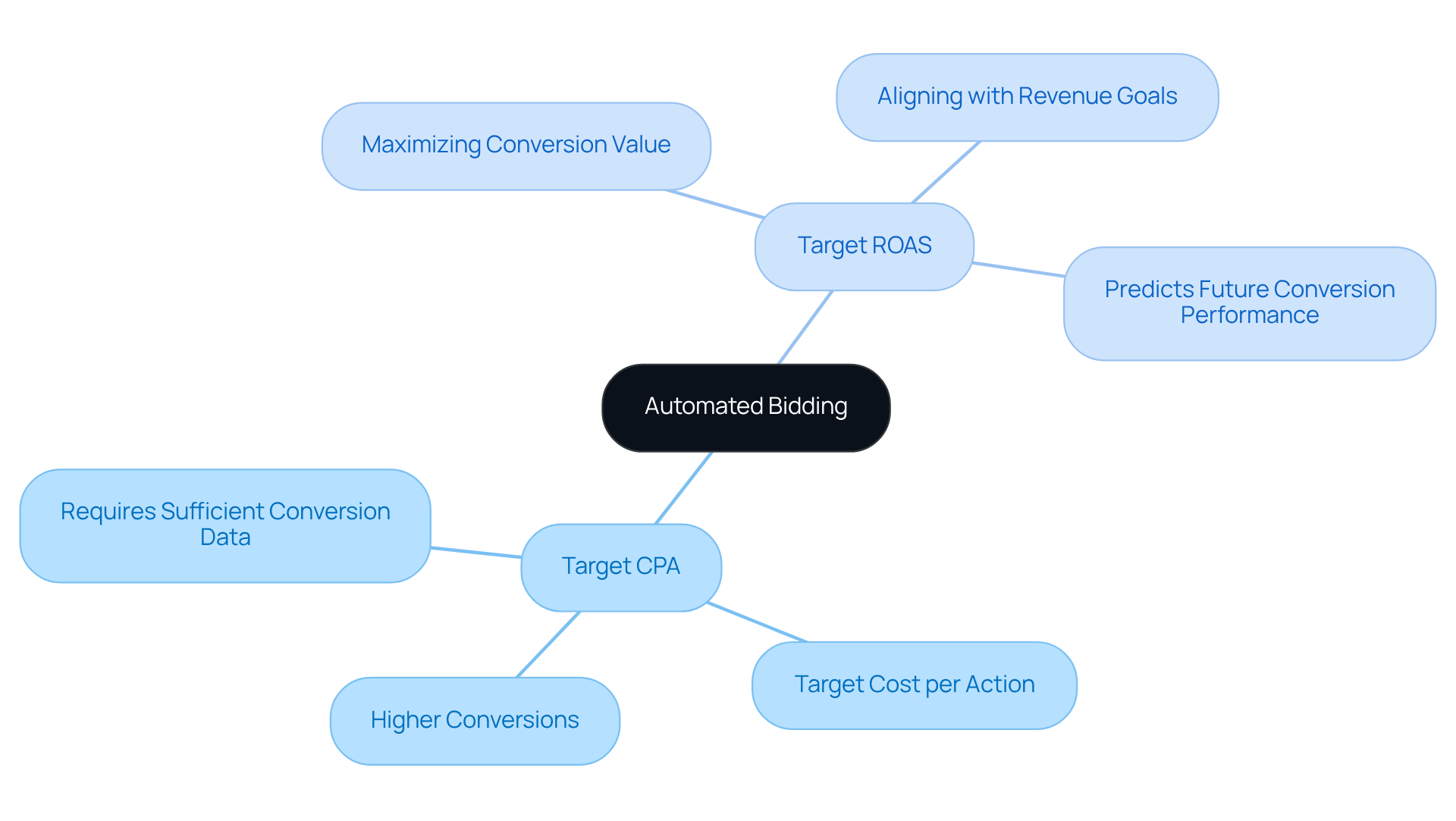
Conduct Competitor Analysis to Identify Winning Tactics
Conducting a comprehensive competitor analysis is essential for DTC companies aiming to uncover effective advertising strategies and develop a successful bid strategy that can be adapted to enhance their own campaigns. By scrutinizing rivals' advertisement text, keywords, and their bid strategy, companies can pinpoint what resonates with their target audience. Utilizing tools like SEMrush and SpyFu provides valuable insights into competitors' advertising expenditures and performance metrics, which can significantly improve their own strategies. For instance, analyzing high-performing ads can unveil successful messaging and creative techniques, while understanding competitors' keyword targeting can highlight market gaps and opportunities. Regularly assessing these insights allows companies to remain agile and competitive, ensuring their bid strategy for Google Ads campaigns is optimized for maximum impact.
Parah Group's case studies illustrate how companies have successfully implemented CRO strategies to boost their performance. For example, a $30M apparel company saw a 35% increase in conversion rates after revamping their homepage to highlight social proof and reviews—an approach that can be mirrored in ad messaging. Similarly, Grab Green, a $15M cleaning product company, enhanced their average order value (AOV) by 80% through strategic pricing and bundling, insights that can guide keyword targeting and ad copy. These case studies underscore the significance of competitor analysis in identifying effective strategies that can elevate ad performance.
Moreover, leveraging the Google Ads Transparency Center offers a transparent view of competitors' ad creatives, which can significantly enhance our bid strategy and further inform strategic decisions. This tool allows companies to analyze the ad messaging, keywords, and value propositions employed by rivals, helping them to refine their bid strategy and improve their own ad copy effectively. As Kaya states, "Competitor ad copy analysis is the targeted dissection of your competitors' ad messaging, including their keywords, tone, CTAs, and value propositions, to identify what works, what doesn’t, and how to refine your own ad copy.
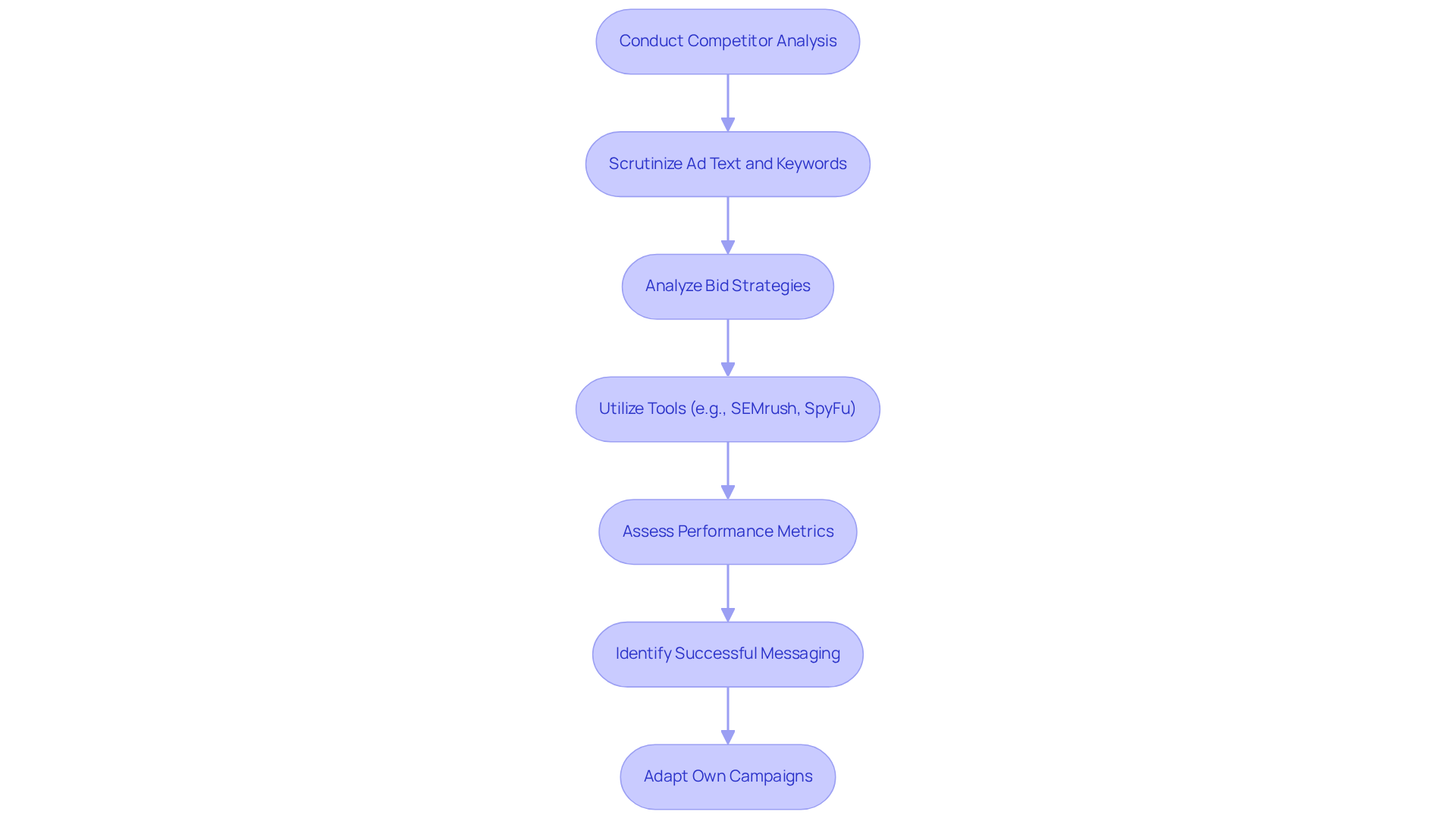
Implement A/B Testing to Optimize Ad Copy and Design
A/B testing stands as a formidable strategy for optimizing ad copy and design, allowing businesses to compare two versions of an ad to identify which performs better. By experimenting with different headlines, visuals, and calls to action, companies can gather critical insights into what drives engagement and results. This iterative process not only promotes continuous improvement but also ensures that ad campaigns evolve based on genuine user feedback and performance metrics.
For instance, organizations leveraging A/B testing have reported significant boosts in conversion rates, with some experiencing a remarkable 15% increase in conversions after refining their ad copy. Marketing experts assert that a methodical approach to A/B testing—where only one variable is altered at a time—is essential for achieving reliable outcomes. This structured methodology empowers DTC companies to systematically enhance their ad performance, utilizing insights gleaned from each test to inform future strategies.
Ultimately, A/B testing equips companies to create a bid strategy that enables data-driven decisions, resulting in more effective advertising and a higher return on ad spend. By embracing this powerful tool, businesses can not only optimize their campaigns but also foster a culture of continuous improvement that resonates with their audience.
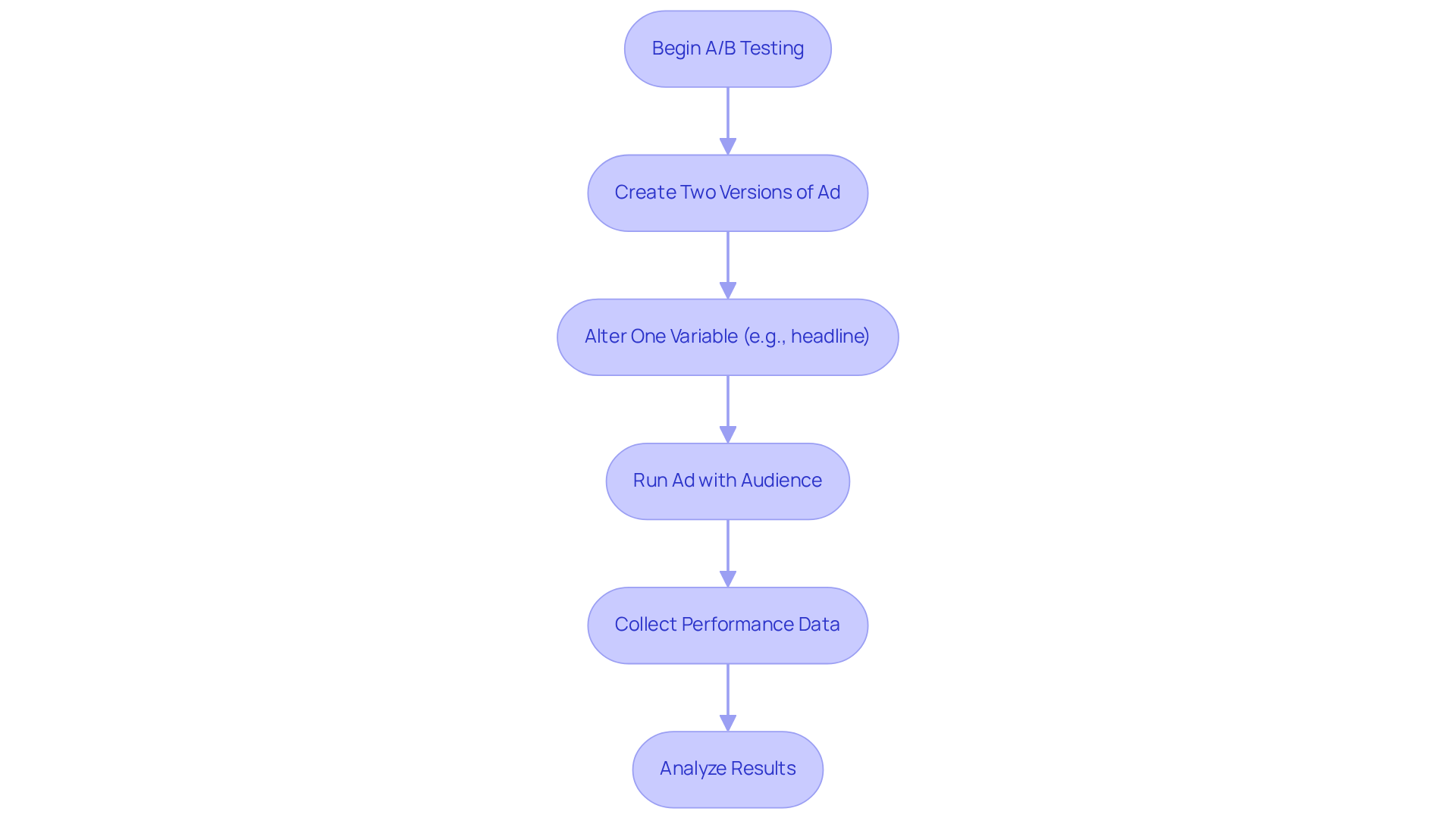
Leverage User Session Recordings for Insightful Consumer Behavior Analysis
User session recordings empower companies to gain profound insights into how potential customers engage with their ads and landing pages. By meticulously analyzing these recordings, businesses can pinpoint specific pain points, distractions, and areas of misunderstanding that may impede desired outcomes. This qualitative data acts as a powerful complement to quantitative metrics, providing a comprehensive view of user behavior.
For example, session recordings can reveal that 50% of visitors bounce off the homepage, underscoring critical areas for improvement. In a recent case study, Parah Group aided a $30M clothing line in redesigning their homepage. They optimized product pricing, gamified the progress bar for free shipping thresholds, and minimized unnecessary pop-ups, resulting in a remarkable 35% increase in conversion rates. Similarly, another case study involving a $15M cleaning product demonstrated that enhancing the purchasing process based on user feedback—such as introducing bundles and multi-packs—led to an impressive 80% rise in average order value.
However, it’s crucial to recognize that session recording should not stand alone; it must be integrated into a broader research strategy to ensure accurate insights. While the session recording process can be time-consuming, companies can streamline this by establishing clear objectives for analysis and prioritizing key user interactions. Comprehensive data analysis and interpretation are vital for effectively utilizing session recordings, as they enable companies to understand user behavior with precision.
By grasping these dynamics, companies can make informed adjustments to their bid strategy, ultimately enhancing ad performance and driving higher conversion rates. Leveraging insights from session recordings allows DTC companies to refine their strategies, ensuring that every aspect of their marketing resonates effectively with their audience.
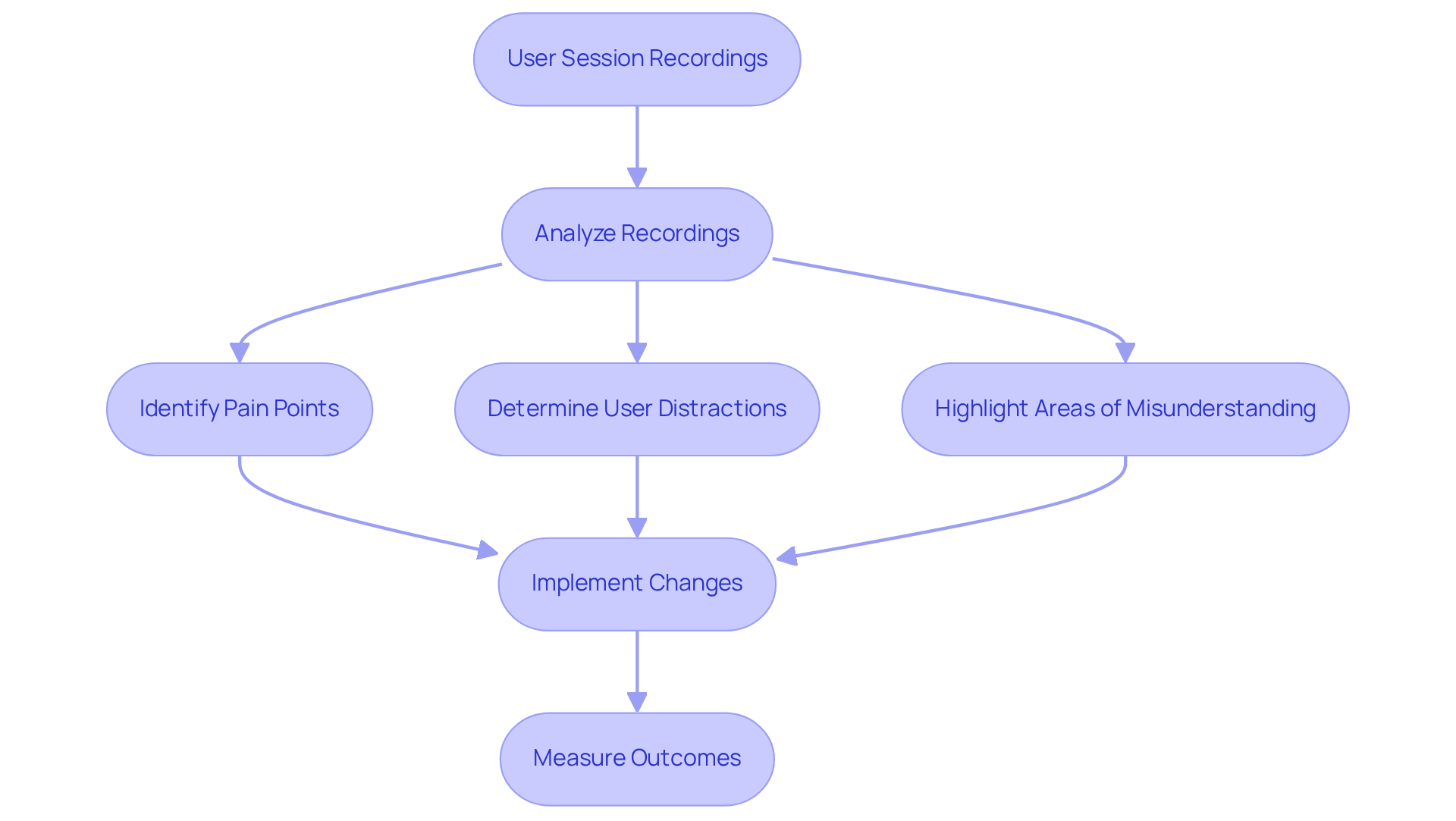
Employ Conversion Copywriting to Enhance Ad Engagement
Conversion copywriting is crucial for crafting messages that truly resonate with your target audience and compel them to take action. By utilizing persuasive language, emotional triggers, and clear calls to action, brands can significantly enhance ad engagement. Understanding the challenges and aspirations of your audience allows for the creation of tailored messaging that meets their needs, ultimately leading to improved conversion outcomes.
For instance, effective ad copy can increase click-through rates by as much as 200%, illustrating the power of well-crafted messages. Moreover, incorporating social proof—such as testimonials—boosts credibility and encourages potential customers to engage with your product or service. Parah Group's case studies highlight the impact of strategic enhancements on DTC companies. A notable example is a $30M clothing line that saw a 35% increase in conversion rates after revamping their homepage to spotlight social proof and reviews, alongside integrating gamified features and post-purchase upsells. Similarly, a $15M cleaning product company improved their average order value (AOV) by 80% through focused messaging and bundling techniques.
These results underscore the significance of social proof, as 92% of consumers trust recommendations from friends and family, which further encourages potential customers to engage with your offerings. By focusing on these elements and applying the AIDA formula—Attention, Interest, Desire, Action—in your messaging, DTC companies can transform their advertising strategies and achieve remarkable performance improvements. Consider implementing the AIDA formula in your next ad campaign to elevate engagement.

Focus on UI/UX Design for a Streamlined Ad Experience
UI/UX design is crucial in shaping how users interact with ads and landing pages. A visually appealing and easy-to-navigate ad can dramatically lower bounce rates—research indicates that a seamless user journey can boost completed purchases by as much as 70%. For instance, Parah Group's partnership with a $30M clothing label resulted in a 35% increase in engagement after they revamped the homepage layout to highlight social validation, reduced intrusive pop-ups, and made the free shipping progress bar more interactive.
Brands must prioritize user-centric design principles, ensuring that every aspect of the ad experience is intuitive and meets user expectations. As Tom Alexander, Digital Design Director, aptly puts it, "Great design isn’t about adding more bells and whistles. It’s about removing friction and anticipating what users need before they even ask." This philosophy not only enhances the effectiveness of ad campaigns but also cultivates a stronger connection with potential customers.
Moreover, incorporating emerging trends such as AI-driven personalization and 3D elements can further elevate engagement levels, leading to higher conversion rates for direct-to-consumer companies. Continuous user testing and analytics are vital for optimizing UX and improving digital marketing outcomes, as evidenced by Parah Group's strategies that have consistently driven revenue growth and enhanced profitability for their clients.
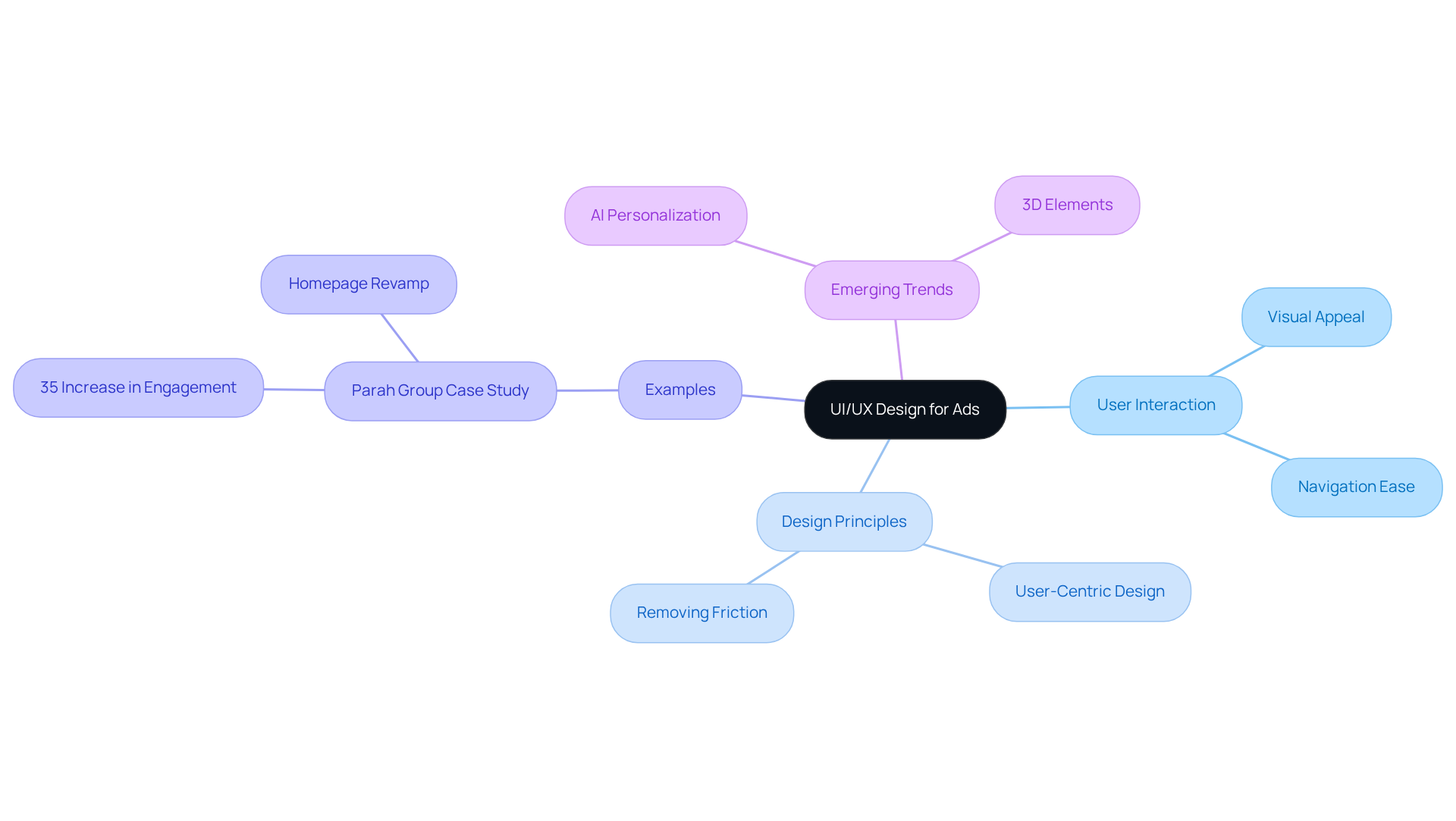
Utilize Customer Surveys to Gather Feedback for Ad Improvement
Customer surveys are essential for gaining insights directly from your target audience. By asking specific questions about ad perceptions, preferences, and experiences, companies can gather invaluable feedback that informs their bid strategy for future advertising. This direct connection to consumer opinions enables businesses to identify what truly resonates with their audience, leading to more targeted and effective advertising initiatives.
Engaging with customers through surveys not only deepens understanding but also fosters a sense of involvement, making consumers feel valued and heard. To strengthen this relationship, companies should follow up with customers after implementing changes based on their feedback. This demonstrates that their opinions matter, enhancing satisfaction and loyalty.
Moreover, personalizing feedback solicitation emails is crucial for connecting with customers on a deeper level. Transparency about how their feedback will be utilized builds trust and encourages ongoing engagement. As a result, companies can refine their messaging and optimize their bid strategy to better align with consumer expectations, ultimately driving improved performance and engagement.
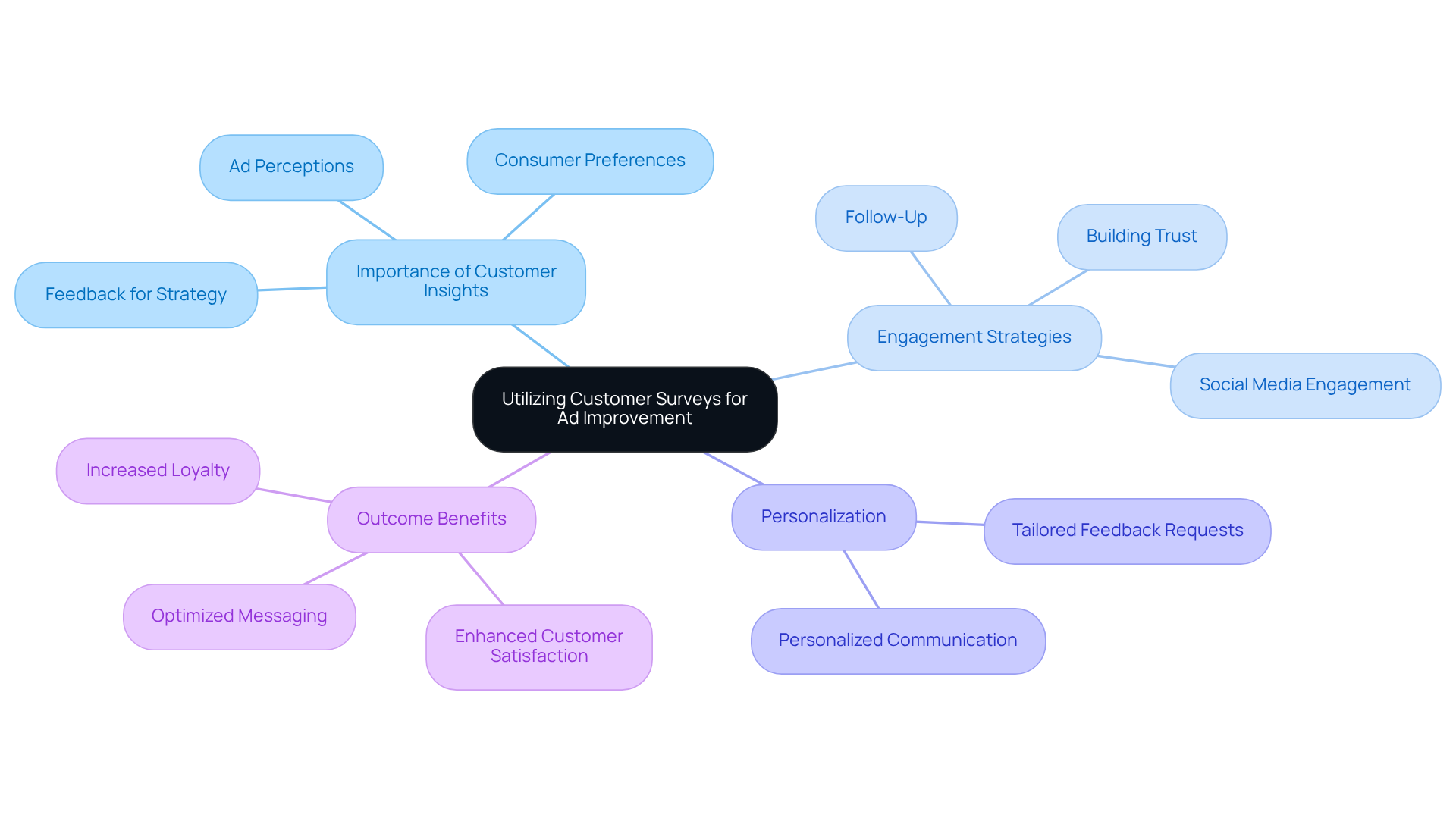
Monitor Performance Continuously to Adjust Bid Strategies
Regular observation of key advertising performance indicators—such as click-through percentages, acquisition rates, and cost per acquisition—is essential for effectively modifying bid strategy. For example, Parah Group's collaboration with a $30M apparel company resulted in a remarkable 35% increase in conversion rates, achieved through strategic homepage redesigns and optimized pricing. By meticulously analyzing these metrics, companies can identify trends that inform budget allocation decisions, ensuring maximum impact.
This proactive approach enables ad campaigns to swiftly adapt to changing market dynamics and consumer behaviors, ultimately enhancing overall performance. As industry leaders assert, mastering the art of bid strategy can significantly elevate ROI, making it a critical focus for direct-to-consumer companies striving for sustainable growth. The success stories of companies like Grab Green and STRNG Seeds further illustrate how targeted conversion rate optimization (CRO) efforts can drive substantial revenue growth and improve profitability, reinforcing the necessity for continuous performance monitoring.
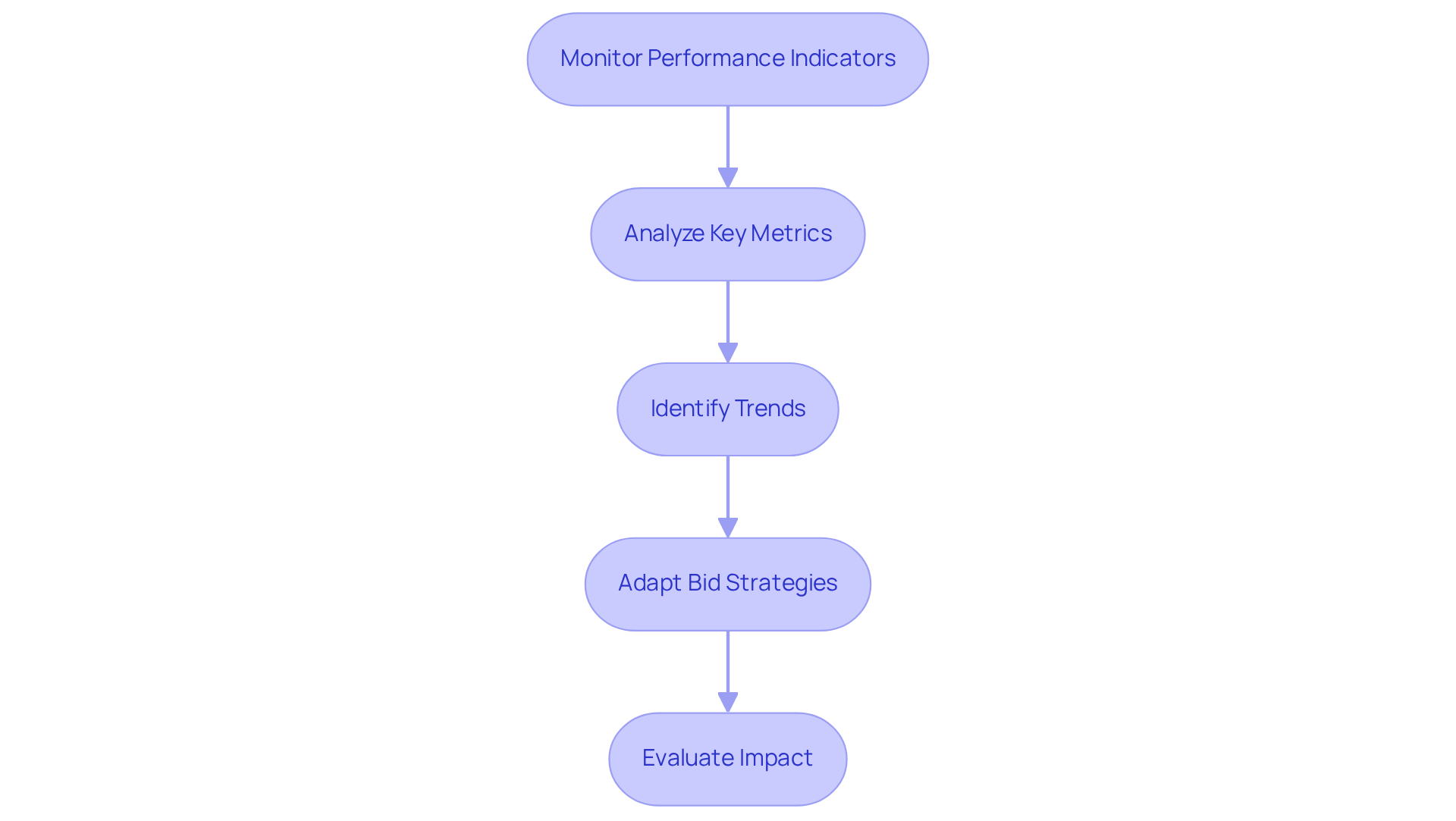
Maximize ROI by Adjusting Strategies Based on Data Insights
To maximize ROI, companies must adopt a flexible approach to their advertising plans, driven by data insights. Analyzing performance metrics is essential for pinpointing effective tactics and identifying areas for improvement. This enables strategic pivots that enhance campaign effectiveness.
For instance, Parah Group has successfully transformed DTC product profitability through innovative methods aimed at boosting user engagement. They gamified the progress bar for free shipping limits and refined product pricing. These strategies have led to impressive results, with case studies showing companies achieving up to a 35% increase in conversion rates and a 10% rise in revenue per visitor.
Ongoing enhancement of advertising strategies, grounded in empirical evidence, not only maximizes expenditure but also ensures that promotional efforts yield the highest possible returns. By leveraging performance data, DTC brands can fine-tune their strategies, ensuring they remain competitive and effective in their advertising endeavors.
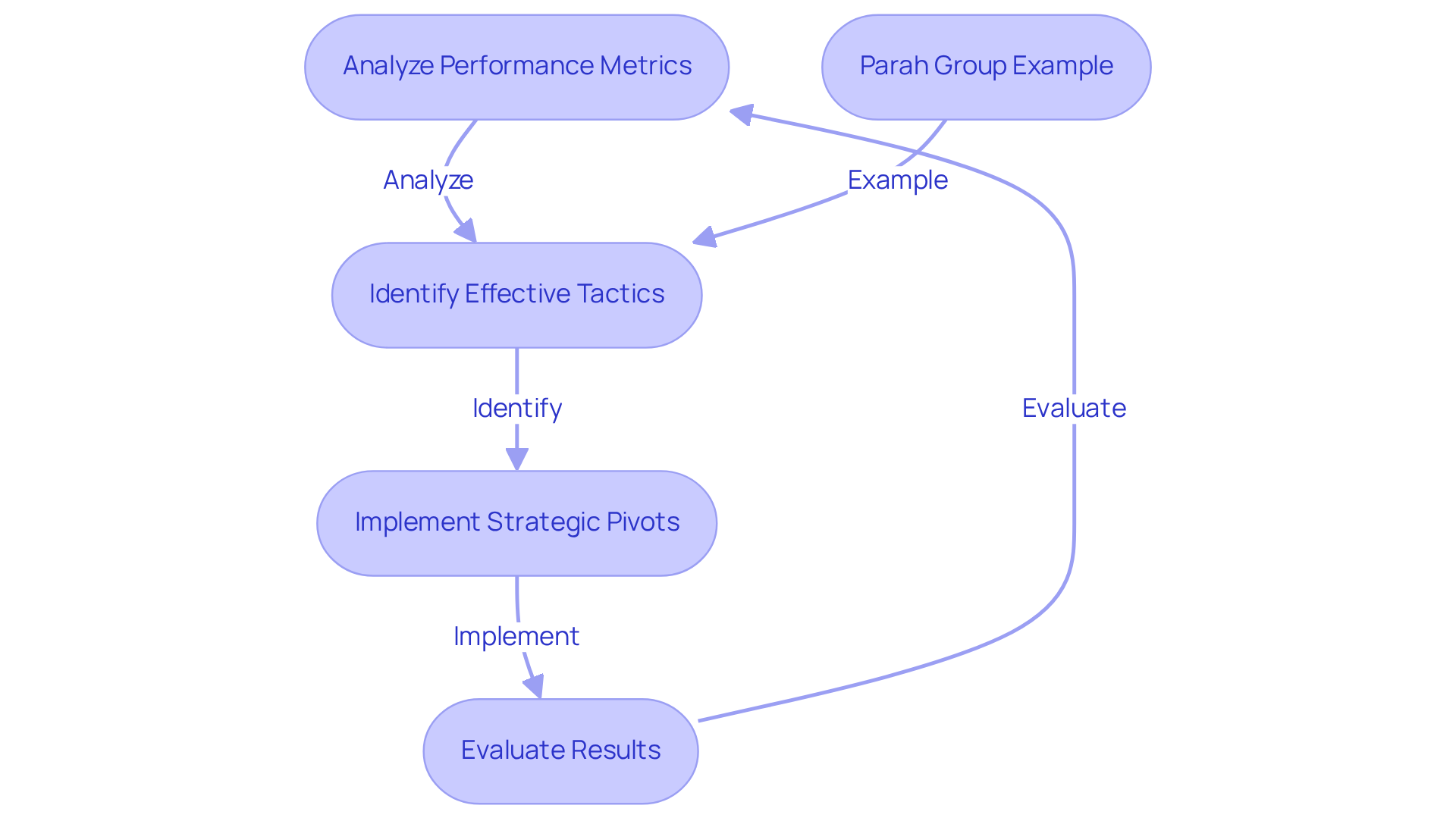
Conclusion
Incorporating effective bid strategies is crucial for optimizing Google Ads performance and ensuring that advertising investments yield substantial returns. By leveraging a combination of Conversion Rate Optimization (CRO) techniques, automated bidding, competitor analysis, and continuous performance monitoring, companies can refine their advertising approaches to drive significant improvements in conversion rates and overall profitability.
Key strategies include:
- Utilizing automated bidding methods to enhance efficiency
- Conducting thorough competitor analysis to identify successful tactics
- Implementing A/B testing to optimize ad copy and design
Insights from user session recordings and customer surveys provide invaluable feedback that can inform adjustments to ad strategies, ultimately leading to more effective campaigns. The examples of companies achieving remarkable results through these methods underscore the importance of a data-driven approach in the ever-evolving landscape of digital advertising.
To maximize the impact of Google Ads campaigns, businesses must commit to a culture of continuous improvement and adaptation based on real-time data insights. By embracing these strategies, companies can not only enhance their ad performance but also foster sustainable growth in a competitive marketplace. Taking proactive steps in refining advertising efforts is crucial, as the potential for increased engagement and higher conversion rates is within reach for those willing to invest in these proven methodologies.
Frequently Asked Questions
What is Parah Group known for in relation to Google Ads?
Parah Group is recognized for integrating Conversion Rate Optimization (CRO) techniques within Google Ads campaigns to maximize returns on advertising spend.
How does Parah Group help DTC companies improve their advertising strategies?
By leveraging data-informed insights and understanding consumer psychology, Parah Group helps DTC labels refine their advertising strategies, leading to improved success metrics and higher average order values.
Can you provide an example of a company that benefited from Parah Group's strategies?
A $30M apparel company saw a 35% increase in conversion rates after revamping its homepage to emphasize social proof, optimize product pricing, and introduce gamified progress bars for free shipping thresholds.
What are some proven methodologies used by Parah Group?
Proven methodologies include A/B testing—where one variable is tested at a time for accurate results—and the creation of personalized landing pages.
How can implementing a bid strategy through CRO affect cost per acquisition (CPA)?
Implementing a bid strategy through CRO can reduce cost per acquisition (CPA) significantly, for example, from $500 to $200.
What are automated bidding methods in Google Ads?
Automated bidding methods, such as Target CPA and Target ROAS, allow advertisers to set bids automatically based on specific objectives, optimizing bids in real-time.
What advantages do automated bidding strategies offer to DTC companies?
Automated bidding strategies save time, enhance campaign efficiency, and allow companies to quickly adapt to market fluctuations and consumer behavior.
Why is competitor analysis important for DTC companies?
Competitor analysis helps DTC companies uncover effective advertising strategies by examining rivals' advertisement text, keywords, and bid strategies, allowing them to refine their own campaigns.
What tools can be used for conducting competitor analysis?
Tools like SEMrush and SpyFu can provide valuable insights into competitors' advertising expenditures and performance metrics.
How can the Google Ads Transparency Center assist in competitor analysis?
The Google Ads Transparency Center offers a view of competitors' ad creatives, helping companies analyze messaging, keywords, and value propositions to refine their own bid strategy and ad copy.
FAQs











